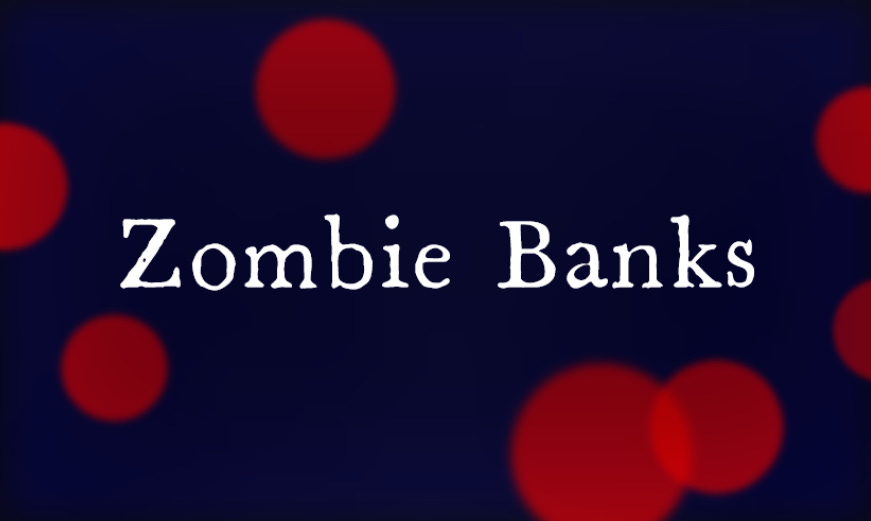A Bankrupt or Defaulting financial institution with a net worth of less than zero or negative net worth that is able to continue operating by the implicit support from the government.
Banks have been in existence since human society started the business of trade. The modern banking system completely eliminated the need to store hard cash and helped to save a huge proportion of public wealth that used to get stolen or spoiled in storage. Before modern banks people would borrow money from wealthy individuals with exorbitant interest rates. In the process, the borrower would always remain in debt because that most people couldn’t afford to pay. To break the whole loan shark system, Modern banks started providing cheaper loans to the underprivileged section of society. With the help of credit creation, Banks create money by lending a lot more money than the deposits that it holds. Function of the bank is so powerful that the entire economy of a country relies on it; By lending money creates employment and spending power which exponentially grow the economy. The establishment of modern banks helped people and businesses in a way that was not possible because many banks today operate at globally. Modern banks have benefited society in many ways and the rise of banks has been a blessing for the economy and society.
Technically as such zombie banks are insolvent and they will not be able to operate or survive without support from the government; As governments allows these banks to pay back their debts in the form of bailouts or guarantees, or credit support.
Thanks to explicit or implicit support from the government, Zombie banks are kept afloat to prevent panic from spreading to other properly functioning banks. At a previous or earlier time; a bank running at a significant loss will eventually be forced into bankruptcy, at which point its assets will be sold off to pay down as many debts as possible. Government intervention surfaced later on when it became clear that struggling financial institutions incite panic.
This type of gamble in lending despite financial weakness is called “zombie lending,” “evergreening,” “forbearance lending,”.
Forbearance is allowing postponement of payments; For example, A bank allows a borrower to temporarily stop or suspend payments of the loan. Forbearance lending is a major practice followed by zombie banks as an effort to extend loan time to their clients.
By doing so, banks hope that the borrowers can get more time to repay the loan by engaging in their business.
The term zombie bank was first coined by Edward Kane of Boston College in 1987, Later, the term was also used when talking about the Japanese banking crisis in the ’90s and the 2009 financial crisis.
Enabling these zombie banks to continue operating comes with drawbacks but restoring these zombie banks back to health can cost huge money and weigh on economic growth. However, Shutting down struggling banks can incite widespread panic.
A Bank becomes Zombie Bank when the banks’ total assets are subtracted from their total liabilities, their net worth comes to be negative.
Since these banks are technically dead and appears to be okay and healthy from the outside. But they truly feed on the money from the government, Hence the term zombie is used.
Since 2008’s financial crisis, Europe has become one of the world’s prime breeding grounds for such institutions. Risky investments by banks were a major contributing factor behind the banking crisis that started in 2007-2008.
Real Zombie Bank Examples:
Japan’s Zombie Banks
From 1990 onwards, Japan has had a particularly torrid experience with zombie banks; a collapse in Japan’s real estate prices and the stock market, sent several of the country’s major banks into insolvency. However, rather than recapitalizing them or letting them go bust, the Japanese government continued to support these banks through guarantees and bailouts. These banks locked Japan’s economy into an economic deflation trap as nearly 30 years later, Japan's zombie banks still have large amounts of non-performing loans on their books. Despite struggling themselves, the banks in some cases continued to allocate credit to severely impaired troubled customers by writing down their bad loans similarly known as zombie companies. With no injection being provided back into the economy, by these zombie banks resulting in a significant drag on the country’s gross domestic product (GDP) growth, later on these timeline is known as the Japan’s “lost decade”.
Europe’s Zombie Banks
Europe made such a similar mistake on the lines of Japan in the 2008 financial crisis in its desperation to avoid becoming Japan. Zombie banks that are dependent on European Central Bank (ECB) liquidity may be unable to absorb the losses if zombie companies, which have also only survived thanks to the ECB’s cheap finance, go under as Europe's banks are still sitting on bad loans. Harsher capitalisation requirements may need to be implemented if Europe is to escape this sustained period of stagnation, succumbing to the same problems that befell Japan in the 1990s and which continue to plague the country to this day.
Often times, The spiralling growth of the zombie companies that has the direct relation to the creation of zombie banks. Japan’s zombie induced general feeling of unease whose exact cause is difficult to identify during the last 30 years could be mirrored in China in the coming years as significant discrepancies in the true amount of bad debt that Chinese banks have already racked up, the implications for future growth in China could be profound.







